For the last week I have been in New Orleans. I am trying very hard to say “New OR-leans” rather than “New Or- LEANS”, which comes more instinctively to me. I haven’t even bothered with “N’awlins” or “Nola”, because this would just sound naff and stupid.
 As in New York, I feel I’ve done a lot and am still trying to pull it all into a coherent picture. I’ve visited the French Quarter, the Garden District, Lafaytette Cemetery, Aubadon Park, City Park, the Ogden Museum of Southern Art, Treme, the NOMA sculpture garden, Oak Alley Planation, the Voodoo Museum and the Bayou, where I held a tiny ‘gator. (I’ve adopted this last contraction for the sake of concision as much as local colour. “Alligator” is such a mouthful and he was an appealing little critter, like a mini velociraptor: five years old, so quite mature really, but still only the length of a ruler; light and agile with damp, pliant, elastic skin and claws like pine-nuts.) I have ridden a street car, sat by the Mississippi, watched a steamboat pull out, drunk wine on wrought-iron terraces, attended a southern cookery class and eaten po-boys, remoulade, gumbo, jambalaya, beignets, pralines and biscuits (oh, so many biscuits). I have heard a lot of jazz.
As in New York, I feel I’ve done a lot and am still trying to pull it all into a coherent picture. I’ve visited the French Quarter, the Garden District, Lafaytette Cemetery, Aubadon Park, City Park, the Ogden Museum of Southern Art, Treme, the NOMA sculpture garden, Oak Alley Planation, the Voodoo Museum and the Bayou, where I held a tiny ‘gator. (I’ve adopted this last contraction for the sake of concision as much as local colour. “Alligator” is such a mouthful and he was an appealing little critter, like a mini velociraptor: five years old, so quite mature really, but still only the length of a ruler; light and agile with damp, pliant, elastic skin and claws like pine-nuts.) I have ridden a street car, sat by the Mississippi, watched a steamboat pull out, drunk wine on wrought-iron terraces, attended a southern cookery class and eaten po-boys, remoulade, gumbo, jambalaya, beignets, pralines and biscuits (oh, so many biscuits). I have heard a lot of jazz.
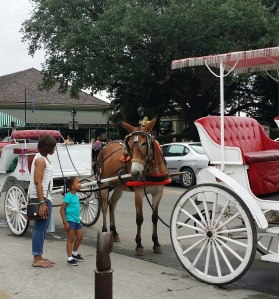 Somewhat predictably, my favourite place is the French Quarter, which is exactly what I hoped New Orleans would be: a honeycombed maze of gleaming shopfronts, restaurants with balconies overlooking the streets, gas lamps which flicker even during the day and hanging baskets of geraniums and petunias. It’s unashamedly touristy but all the better for it. Antiques shops, chocolate shops, jewellery shops, tacky gift shops, perfumiers and visitors’ centres nestle comfortably side by side. The streets all have that close, cosy, alley-like feel to them, and while they’re not actually cobbled, they manage to give the impression of being so. Patient horses clip-clop by, pulling covered wagons of tourists. Their manes (the horses’, that is) are threaded with plastic flowers, their heads bowed, their elongated faces sweet and stoic. It’s like walking through a historical film set, everything bathed in a golden glow and almost heart-wrenchingly quaint and rusticated.
Somewhat predictably, my favourite place is the French Quarter, which is exactly what I hoped New Orleans would be: a honeycombed maze of gleaming shopfronts, restaurants with balconies overlooking the streets, gas lamps which flicker even during the day and hanging baskets of geraniums and petunias. It’s unashamedly touristy but all the better for it. Antiques shops, chocolate shops, jewellery shops, tacky gift shops, perfumiers and visitors’ centres nestle comfortably side by side. The streets all have that close, cosy, alley-like feel to them, and while they’re not actually cobbled, they manage to give the impression of being so. Patient horses clip-clop by, pulling covered wagons of tourists. Their manes (the horses’, that is) are threaded with plastic flowers, their heads bowed, their elongated faces sweet and stoic. It’s like walking through a historical film set, everything bathed in a golden glow and almost heart-wrenchingly quaint and rusticated.
It’s fun to watch the people too. Buxom women trip by in poodle skirts, cat-eye sunglasses and red lipstick. Buskers and beggars are everywhere. People carry plastic tumblers of beer  in the streets – conservative-looking couples from Kansas as well as crowds of stumbling frat boys – and think nothing of raising their glass to any passing policeman in a cheery “good evening” or “good morning officer” . It’s like one big never-ending music festival. Once it hits 4pm, on every street corner you see a long-haired tour guide in jeans and a black top hat regaling his gawping audience with lurid tales of murder, spectres, zombies and bad gris-gris: if you’re leading a ghost tour, looking like you’re off to a Marilyn Manson concert is apparently mandatory. The smell of caramel, garbage, greasy beignets, urine and the faint, muddy tang of the river hangs over everything.
in the streets – conservative-looking couples from Kansas as well as crowds of stumbling frat boys – and think nothing of raising their glass to any passing policeman in a cheery “good evening” or “good morning officer” . It’s like one big never-ending music festival. Once it hits 4pm, on every street corner you see a long-haired tour guide in jeans and a black top hat regaling his gawping audience with lurid tales of murder, spectres, zombies and bad gris-gris: if you’re leading a ghost tour, looking like you’re off to a Marilyn Manson concert is apparently mandatory. The smell of caramel, garbage, greasy beignets, urine and the faint, muddy tang of the river hangs over everything.
I have chosen the place where I’m staying because it looked pleasantly ramshackle and bohemian in the photos and was advertised as being in the French Quarter. “It ain’t fancy”, the first line of the ad said, but I was prepared to take my chances.
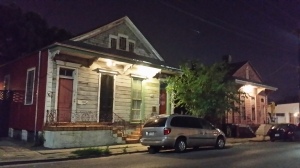 The street is pretty and picturesque in a shabby, paint-peeling, down-at-heel kind of way, but it’s clear even to me that it’s on the wrong side of the tracks. There’re an awful lot of abandoned tyres lying around, for one thing, and vacant lots are common. Street signs typically hang askew and are covered with graffiti. There are lots of cars cruising about with loud, thumping music. And there are lots of people hanging out on stoops.
The street is pretty and picturesque in a shabby, paint-peeling, down-at-heel kind of way, but it’s clear even to me that it’s on the wrong side of the tracks. There’re an awful lot of abandoned tyres lying around, for one thing, and vacant lots are common. Street signs typically hang askew and are covered with graffiti. There are lots of cars cruising about with loud, thumping music. And there are lots of people hanging out on stoops.
Please note that in normal circumstances I have no objection to hanging out on stoops: in fact, one of the chief pleasures of my daily routine at home is enjoying a cup of coffee on the back doorstep in the morning sun with the cat winding companionably around my ankles and occasionally sinking her teeth into my shins. But while I am a fervent advocate of the manifold delights of steps and stoops, the stoop you are sitting on should be your own.
 This sentiment is shared by the woman who owns the house that I’m staying in. I’ve never met her, but she leaves detailed instructions to help me settle in. Wine is a prominent theme in these instructions. She explicitly mentions that the food and cosmetics in the house should not be touched, however, guests should feel free to help themselves to booze. Several half empty bottles of wine are left in the fridge for this apparent purpose, which I feel is an extremely friendly and hospitable gesture and quite makes up for the fact that there is no extra toilet paper or bathmat, and the only towel provided looks like it’s been half-consumed by moths. I also like how she describes the kitchen as being “terrific for hanging out and drinking wine in”. If we ever meet, I’m sure we’d get on famously.
This sentiment is shared by the woman who owns the house that I’m staying in. I’ve never met her, but she leaves detailed instructions to help me settle in. Wine is a prominent theme in these instructions. She explicitly mentions that the food and cosmetics in the house should not be touched, however, guests should feel free to help themselves to booze. Several half empty bottles of wine are left in the fridge for this apparent purpose, which I feel is an extremely friendly and hospitable gesture and quite makes up for the fact that there is no extra toilet paper or bathmat, and the only towel provided looks like it’s been half-consumed by moths. I also like how she describes the kitchen as being “terrific for hanging out and drinking wine in”. If we ever meet, I’m sure we’d get on famously.
Returning to stoops, however, the other theme that comes through in the instructions is the importance of not allowing the neighbours to congregate on the stoop. This is reiterated some three or four times and usually in alarming-looking capital letters. My favourite paragraph (disturbingly included under the heading “Staying Safe”) goes like this: “If you ever see anybody hanging out on the front stoop, please tell them “you can’t sit here”. I once tried to be nice about it and it escalated into SOMETHING I DIDN’T WANT. So, be territorial about the house and parking spots please.” I find this both tantalising and mildly discomfiting.
I come to appreciate the importance of the stoop issue at around 5pm on the first day. I am drinking wine in the kitchen, as per my host’s instructions, when an almighty clamour starts up outside. For a while I try to ignore it, not being sure what is acceptable round there, but it soon reaches a level so extreme – almost as if the walls are being pelted endlessly with rocks – that I have to clamp my hands over my ears and consider taking cover in the wardrobe.
I tentatively open the door to see what all the commotion is – or rather, try to open it, but am unable to because three large black men are wedged against it. Another three people sit on the step below them, and a good half-dozen or so more sprawl on the footpath or lean against the house, all hollering, jeering, smoking, eating and creating a general racket. This isn’t just a congregation on the stoop – it’s an entire Billy Graham crusade.
I admit I feel vulnerable and intimidated. For a start, there is no back door so I am  physically barricaded in the house. I don’t know the town at all and have no idea what to do if I get into any trouble. I am also acutely aware of being a woman alone in a tiny house and of this being patently obvious to anyone outside.
physically barricaded in the house. I don’t know the town at all and have no idea what to do if I get into any trouble. I am also acutely aware of being a woman alone in a tiny house and of this being patently obvious to anyone outside.
I remember my host’s instructions: be firm, stand your ground, stake your territory. I am not someone who thrives on confrontation and my usual instinct would be to just retreat, try to ignore it and hope it stops. I wonder if there is some other approach I can take. Some local councils in Sydney have instituted the practice of playing uncool music in public spaces at night to deter groups of teenagers from loitering – piping Bing Crosby show tunes or “What a Wonderful World” into train station toilets, for instance. Possibly this would be a less confrontational method. Or possibly it would just get me stabbed (some would say justifiably).
But I’m no coward (I hope). And if I don’t summon up the backbone to say something now, I might have to put up with another six days of this cacophony – and I’m not sure I can take that.
Bracing myself, I push against the door with my full weight, take a deep breath and draw on the full measure of my power and stature as a children’s librarian: “Guys, I’m sorry, but you can’t sit there, OK?”, I say in a loud, clear voice. The use of the word “guys” is a calculated risk: I am a little concerned that it might sound patronisingly “ole’ buddy-ish”, or that the women in the group might see it as a slight against their femininity, but decide to stick with it on the grounds that it creates an atmosphere of friendliness and amelioration without making me come across as a pushover. Possibly I am overthinking my choice of vocabulary. I try to sound assertive rather than apologetic or pleading. I also try not to talk like an English nanny or an amateur thespian as I sense this might be enraging. “You can’t sit there,” I say again firmly.
The noise abruptly stops. A woman on the lower steps gets up and heaves herself around to look at me. She is about three times my weight. She isn’t smiling. “Oh, Ah’m sorry – you don’t want us all to sit here?” she says, her tone brash and challenging rather than apologetic, making me suspect that some uncomplimentary remark about my mama is forthcoming.
“It’s really noisy,” I say, hoping this is a reasonable justification to give. Maybe there is some other reason that would have worked better: an ancient territorial claim to the stoop for instance, or an invocation of some sort of civic bylaw about gatherings without a permit – but I stick with the querulous-sounding, “It’s really noisy”. And with that, they all get up and shuffle off, presumably to another stoop somewhere.
I go to bed oddly elated that night, but spend most of the night wide-awake and tense, expecting some type of retaliation: screamed threats, kids rattling the windows or really insulting handwritten poems pushed under the door. Nothing happens though and I eventually go to sleep.
Variations of this encounter are repeated several times more over the next few days. I come to think of it as the ritual “clearing of the stoop”. It is still intimidating, but becomes less so over time, and eventually it tapers off then stops altogether.
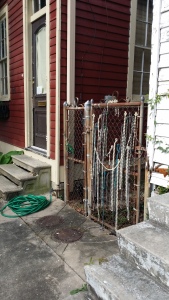 In the meantime, I nod and say “hey” to everyone I walk by on the street, and they nod back in return. The children call me “ma’am”, and on Sunday, all wish me a happy Mother’s Day. At the corner, a young man in a singlet sits slumped on a battered, rust-coloured couch pushed up against a rubble-filled dumpster. He is always there, whatever time of the day or night I pass. Each time, he wishes me a “good day”, his manner exquisitely polite, almost courtly.
In the meantime, I nod and say “hey” to everyone I walk by on the street, and they nod back in return. The children call me “ma’am”, and on Sunday, all wish me a happy Mother’s Day. At the corner, a young man in a singlet sits slumped on a battered, rust-coloured couch pushed up against a rubble-filled dumpster. He is always there, whatever time of the day or night I pass. Each time, he wishes me a “good day”, his manner exquisitely polite, almost courtly.
I come to notice corn growing in the vacant lots and the screeching of roosters and chickens in the morning. I notice gaudy metallic beads strung defiantly on chainwire fences and the fragile beauty of fairy lights entwined in security grilles. I notice cracked mirrors arranged into mosaics on the footpath; a humble raising of the chin against greyness and ugliness. I could relate this to a broader theme about the character of the people here, their bravery and resilience and spirit in the aftermath of Hurricane Katrina, but I’m not sure I know enough about it and suspect I would just be drawing a neat narrative arc for the sake of it. I notice that sometimes the tyres in the streets are painted like rainbows.

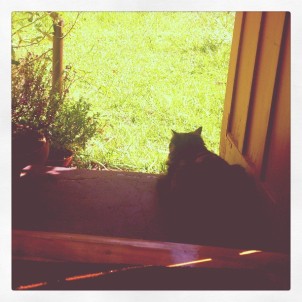






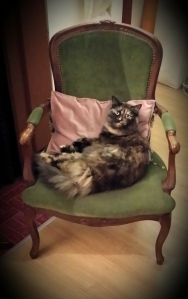

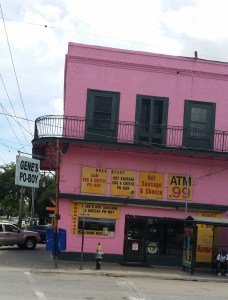














![20150509_115026[1]](https://bakersdaughterwrites.files.wordpress.com/2015/05/20150509_1150261.jpg?w=169&h=300)
![20150513_190131[1]](https://bakersdaughterwrites.files.wordpress.com/2015/05/20150513_1901311.jpg?w=230&h=410)


